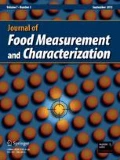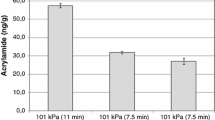Abstract
The purpose of current study is to monitor the Acrylamide (AA) contents in biscuits produced on the industrial scale. Effect of sugar types, inverted sugar syrup and sucrose, and baking conditions including time and temperature on the AA formation were studied in rotary moulded biscuit at the industrial scale. The AA content and the correlation between AA concentration and CIE color space parameters of L*a*b* and C index was studied. The AA formation was effectively decreased by replacement of the inverted sugar syrup of 2% w/w with sucrose of 1% w/w. The least AA content was found in samples made with 5% inverted sugar and 15% sucrose and the highest concentration of AA was observed in samples made with 9% inverted sugar and 13% sucrose. The effect of sugar on acrylamide formation was pronounced for inverted sugar and sucrose, expectedly. To assess the effect of baking condition, increasing the mean temperature of three zones of tunnel oven from 307 to 320 °C led to rising AA concentration, while the amount of AA reduced with increasing the mean oven temperature from above 320 °C. The results of the color analysis of biscuit samples revealed that a significant correlation was observed between AA concentration and brightness parameter L*, while parameters a*, b* and C did not show significant differences. The overall results suggest that the industrial rotary moulded biscuit without any difference in overall acceptability, but having the lowest acrylamide content can be manufactured by decreasing the baking mean temperature for a long time and also replacing inverted sugar syrup with sucrose.




Similar content being viewed by others
References
L. Ahrné, C.G. Andersson, P. Floberg, J. Rosén, H. Lingnert, Effect of crust temperature and water content on acrylamide formation during baking of white bread: steam and falling temperature baking. LWT Food Sci. Technol. 40(10), 1708–1715 (2007). https://doi.org/10.1016/j.lwt.2007.01.010
T.M. Amrein, B. Schönbächler, F. Escher, R. Amadò, Factors influencing acrylamide formation in gingerbread. Adv. Exp. Med. Biol. 561, 431–446 (2005). https://doi.org/10.1007/0-387-24980-X_33
E. Bartkiene, I. Jakobsone, G. Juodeikiene, D. Vidmantiene, I. Pugajeva, V. Bartkevics, Study on the reduction of acrylamide in mixed rye bread by fermentation with bacteriocin-like inhibitory substances producing lactic acid bacteria in combination with Aspergillus niger glucoamylase. Food Control 30(1), 35–40 (2013). https://doi.org/10.1016/j.foodcont.2012.07.012
A. Becalski, B.P.Y. Lau, D. Lewis, S.W. Seaman, Acrylamide in foods: occurrence, sources, and modeling. J. Agric. Food Chem. 51(3), 802–808 (2003). https://doi.org/10.1021/jf020889y
M. Biedermann, K. Grob, Model studies on acrylamide formation in potato, wheat flour and corn starch; ways to reduce acrylamide contents in bakery ware. Mitt. Lebensm. Hyg. 94, 406–422 (2003)
E. Bråthen, S.H. Knutsen, Effect of temperature and time on the formation of acrylamide in starch-based and cereal model systems, flat breads and bread. Food Chem. 92(4), 693–700 (2005). https://doi.org/10.1016/j.foodchem.2004.08.030
L. Castle, M.-J. Campos, J. Gilbert, Determination of acrylamide monomer in hydroponically grown tomato fruits by capillary gas chromatography—mass spectrometry. J. Sci. Food Agric. 54(4), 549–555 (1991). https://doi.org/10.1002/jsfa.2740540406
CIAA Acrylamide Toolbax (2006) Confederation of the food and drink industries of the EU, www.ciaa.be.
A. Claus, M. Mongili, G. Weisz, A. Schieber, R. Carle, Impact of formulation and technological factors on the acrylamide content of wheat bread and bread rolls. J. Cereal Sci. 47(3), 546–554 (2008). https://doi.org/10.1016/j.jcs.2007.06.011
Commission Regulation (EU) 2017/2158 (2017) Establishing mitigation measures and benchmark levels for the reduction of the presence of acrylamide in food. https://fooddrinkeurope.eu
S. Eslamizad, F. Kobarfard, C. Tsitsimpikou, A. Tsatsakis, K. Tabib, H. Yazdanpanah, Health risk assessment of acrylamide in bread in Iran using LC-MS/MS. Food Chem. Toxicol. 126, 162–168 (2019). https://doi.org/10.1016/j.fct.2019.02.019
V. Gökmen, H.Z. Şenyuva, B. Dülek, A.E. Çetin, Computer vision-based image analysis for the estimation of acrylamide concentrations of potato chips and French fries. Food Chem. 101(2), 791–798 (2007). https://doi.org/10.1016/j.foodchem.2006.02.034
V. Gökmen, Ö.Ç. Açar, G. Arribas-Lorenzo, F.J. Morales, Investigating the correlation between acrylamide content and browning ratio of model cookies. J. Food Eng. 87(3), 380–385 (2008). https://doi.org/10.1016/j.jfoodeng.2007.12.029
V. Gökmen, Ö.Ç. Açar, H. Köksel, J. Acar, Effects of dough formula and baking conditions on acrylamide and hydroxymethylfurfural formation in cookies. Food Chem. 104(3), 1136–1142 (2007). https://doi.org/10.1016/j.foodchem.2007.01.008
V. Gökmen, T.K. Palazoǧlu, Acrylamide formation in foods during thermal processing with a focus on frying. Food Bioprocess Technol. 1(1), 35–42 (2008). https://doi.org/10.1007/s11947-007-0005-2
V. Gökmen, H.Z. Şenyuva, Study of colour and acrylamide formation in coffee, wheat flour and potato chips during heating. Food Chem. 99(2), 238–243 (2006). https://doi.org/10.1016/j.foodchem.2005.06.054
V. Gökmen, H.Z. Şenyuva, J. Acar, K. Sarioǧlu, Determination of acrylamide in potato chips and crisps by high-performance liquid chromatography. J. Chromatogr. A 1088(1–2), 193–199 (2005). https://doi.org/10.1016/j.chroma.2004.10.094
M. Graf, T.M. Amrein, S. Graf, R. Szalay, F. Escher, R. Amadò, Reducing the acrylamide content of a semi-finished biscuit on industrial scale. LWT - Food Sci. Technol. 39(7), 724–728 (2006). https://doi.org/10.1016/j.lwt.2005.05.010
N. Haase, B. Matthaeus, K. Vosmann, Acrylamide in baked products-state of the art. Getreide Mehl und Brot 57(3), 180–184 (2003)
International Agency on Research on Cancer (1994) IARC monographs on the evaluation of carcinogenic risk of chemicals to man. https://www.Iarc.fr.
L.S. Jackson, F. Al-Taher, Effects of consumer food preparation on acrylamide formation. Adv. Exp. Med. Biol. 561, 447–465 (2005). https://doi.org/10.1007/0-387-24980-X_34
J. Keramat, A. LeBail, C. Prost, N. Soltanizadeh, Acrylamide in foods: chemistry and analysis. A review. Food Bioprocess Technol. 4, 340–363 (2011). https://doi.org/10.1007/s11947-010-0470-x
J. Keramat, A. LeBail, C. Prost, M. Jafari, Acrylamide in baking products: a review article. Food Bioprocess Technol. 4, 530–543 (2011). https://doi.org/10.1007/s11947-010-0495-1
E.J.M. Konings, P. Ashby, C.G. Hamlet, G.A.K. Thompson, Acrylamide in cereal and cereal products: a review on progress in level reduction. Food Addit. Contam. 24(SUPPL. 1), 47–59 (2007). https://doi.org/10.1080/02652030701242566
D.S. Mottram, B.L. Wedzicha, A.T. Dodson, Food chemistry: acrylamide is formed in the Maillard reaction. Nature 419(6906), 448–449 (2002). https://doi.org/10.1038/419448a
L.A. Mucci, H.O. Adami, The role of epidemiology in understanding the relationship between dietary acrylamide and cancer risk in humans. Adv. Exp. Med. Biol. 561, 39–47 (2005). https://doi.org/10.1007/0-387-24980-X_3
A. Mustafa, R. Andersson, J. Rosén, A. Kamal-Eldin, P. Åman, Factors influencing acrylamide content and color in rye crisp bread. J. Agric. Food Chem. 53(15), 5985–5989 (2005). https://doi.org/10.1021/jf050020q
F. Pedreschi, K. Kaack, K. Granby, Reduction of acrylamide formation in potato slices during frying. LWT - Food Sci. Technol. 37(6), 679–685 (2004). https://doi.org/10.1016/j.lwt.2004.03.001
B.J. Petersen, N. Tran, Exposure to acrylamide, Chemistry and Safety of Acrylamide in Food (Springer, Dordrecht, 2006), pp. 63–76. https://doi.org/10.1007/0-387-24980-x_5
P. Sadd, C. Hamlet, The formation of acrylamide in UK cereal products. Adv. Exp. Med. Biol. 561, 415–429 (2005). https://doi.org/10.1007/0-387-24980-X_32
F. Shakeri, S. Shakeri, S. Ghasemi, A.D. Troise, A. Fiore, Effects of formulation and baking process on acrylamide formation in Kolompeh, a traditional cookie in Iran. J. Chem. (2019). https://doi.org/10.1155/2019/1425098
M. Springer, T. Fischer, A. Lehrack, W. Freund, Development of acrylamide in baked products. Getreide Mehl und Brot 57(5), 274–278 (2003)
R.H. Stadler, Acrylamide formation in different foods and potential strategies for reduction. Adv. Exp. Med. Biol. 561, 157–169 (2005). https://doi.org/10.1007/0-387-24980-X_13
N. Surdyk, J. Rosén, R. Andersson, P. Åman, Effects of asparagine, fructose, and baking conditions on acrylamide content in yeast-leavened wheat bread. J. Agric. Food Chem. 52(7), 2047–2051 (2004). https://doi.org/10.1021/jf034999w
Swedish Food Agency (2002) Information about acrylamide in food report [on line]. https://www.livsmedelsverket.se/en/food-and-content/oonskade-amnen/akrylamid.
M. Törnqvist, Acrylamide in food: the discovery and its implications—a historical perspective. Adv. Exp. Med. Biol. 561, 1–19 (2005). https://doi.org/10.1007/0-387-24980-X_1
M. Vass, T.M. Amrein, B. Schonbachler, F. Escher, R. Amado, Ways to reduce acrylamide formation in cracker products. Czech J. Food Sci. 22, 19–21 (2004)
R. Weisshaar, B.G.-D. Lebensmittel-Rundschau, Formation of Acrylamide in Heated Potato Products-Model Experiments Pointing to Asparagine as Precursor (Behr’s Verlag, Hamburg, 2002)
A. Yasuhara, Y. Tanaka, M. Hengel, T. Shibamoto, Gas chromatographic investigation of acrylamide formation in browning model systems. J. Agric. Food Chem. 51(14), 3999–4003 (2003). https://doi.org/10.1021/jf0300947
Y. Zhu, G. Li, Y. Duan, S. Chen, C. Zhang, Y. Li, Application of the standard addition method for the determination of acrylamide in heat-processed starchy foods by gas chromatography with electron capture detector. Food Chem. 109(4), 899–908 (2008). https://doi.org/10.1016/j.foodchem.2008.01.020
Acknowledgments
The authors gratefully acknowledge Isfahan Shirinak Biscuit Factory and appreciate the assistance of Dr.Sadeghian. Moreover, special thanks to the “Food and Drug Administration, Isfahan Medical Department”. This research did not receive any specific grant from funding agencies in the public.
Author information
Authors and Affiliations
Corresponding author
Additional information
Publisher's Note
Springer Nature remains neutral with regard to jurisdictional claims in published maps and institutional affiliations.
Rights and permissions
About this article
Cite this article
Aarabi, F., Seyedain Ardebili, M. The effect of sugar type and baking condition on formation of acrylamide in industrial rotary moulded biscuit. Food Measure 14, 2230–2239 (2020). https://doi.org/10.1007/s11694-020-00470-9
Received:
Accepted:
Published:
Issue Date:
DOI: https://doi.org/10.1007/s11694-020-00470-9




